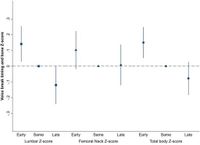A study recently published in Scientific Reports dives into the relationships between pubertal timing and outcomes related to bone density and body composition in young adult men. Researchers analyzed data collected from 2,056 healthy young men, with a median age of 19, focusing on how the timing of voice break—a late milestone of puberty—affects overall health as these individuals transition into adulthood.
The study found significant disparities based on the age at which men reported experiencing their voice break relative to peers. Among the participants, 20% reported an earlier voice break, and these individuals exhibited higher lumbar bone mineral density (BMD) and total body BMD. In contrast, the 17% who reported a later voice break had lower lumbar bone mineral content and bone area, even though their overall BMD remained similar to those with average timing. Men with later voice breaks also displayed lower body mass index (BMI), less lean mass, and a lower fat-to-muscle ratio.
Understanding these variances is critical, as bone and muscle development plays a significant role during puberty—impacting long-term health. Poor bone health can lead to conditions like osteoporosis later in life, thereby emphasizing the importance of reaching peak bone mass during adolescence. Marking these milestones accurately is crucial for distinguishing between physiological development timelines and their implications for overall health.
Conducted at the Rigshospitalet in Copenhagen, Denmark, this cross-sectional study utilized dual-energy X-ray absorptiometry (DXA) for assessing bone density and body composition among participants during mandatory medical examinations prior to military service. The research gathered self-reported data from the men concerning the timing of their pubertal transitions, verifying how these events correlated with physical health markers.
As a distinct indicator of pubertal maturation, the timing of voice break can correlate with larger patterns including testicular development and testosterone levels. In this cohort, the mean age for voice break was found to be approximately 13.6 years, aligning with existing studies that associate this milestone with other critical developments during puberty.
The results revealed that men with a later voice break had noticeably different bone and body compositions. This group recorded much lower lumbar bone mineral content and bone volume. Interestingly, despite these measurements, their overall bone density did not differ from those with average timing. These findings suggest potential ongoing processes of bone development that can extend well into young adulthood, indicating that the impact of late pubertal timing on health could last much longer than previously thought.
Moreover, the participants who reported an earlier voice break demonstrated higher bone mass across the board, but also presented with slightly increased body fat percentages, raising questions about the balance between muscle and body fat as they mature. Notably, while BMI emerged as a distinguishing characteristic across groups, it also coincided with differences in body composition and fat distribution.
The study adds to the body of research examining how physical changes during puberty can serve as determinants of future health. The findings are especially relevant in a landscape where increasing attention is being paid to obesity, metabolic health, and their interplay with developmental milestones.
Ultimately, this research opens avenues for further exploration into the adjustments men may experience based on their individual pubertal trajectories. It underscores the need for tailored health initiatives that factor in these variations to potentially mitigate future risks for obesity and its related metabolic impacts, emphasizing how critical early-life conditions can translate into later health outcomes.
This significant study, appearing at a vital intersection of growth research and public health, highlights how physiological variations in pubertal timing relate to bone and body composition in young adult men, paving the way for ongoing research in developmental health.




